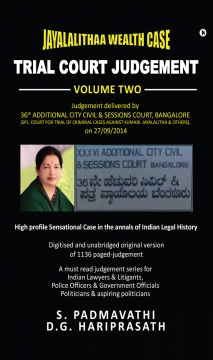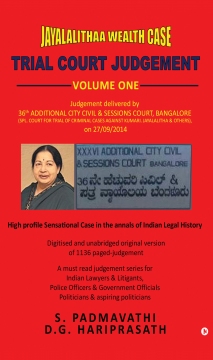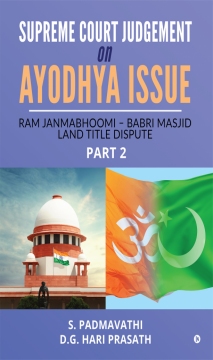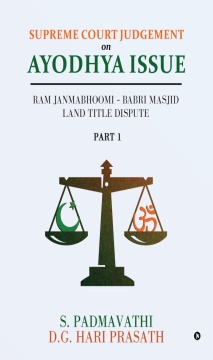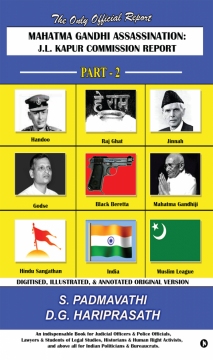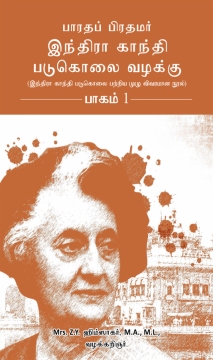
- Discover books
- For Writers
-
For Writers
-
Indie Author Championship
-
Challenges
Writing Contests
- Get Started

"It was a wonderful experience interacting with you and appreciate the way you have planned and executed the whole publication process within the agreed timelines.”
Subrat SaurabhAuthor of Kuch Woh Pal -
-
-
IN
- India
- Singapore
- Malaysia
- 0
S. PADMAVATHI & D.G. HARI PRASATH
Authors S. Padmavathi and D.G. Hariprasath are practising Advocates. The first author is Mrs. S. Padmavathi, born on 14 November 1969. She belongs to a Tamil-speaking Brahmin family and hails from Mahadhanapuram, Karur, Tamil Nadu. She studied law at Bangalore University and Annamalai University. The second author, Mr. D. G. Hari Prasath, graduated from School of Law, SASTRA. He is an advocate at Madras High Court. These series of judgments are being published in digitised version for documentation of important judgments connected to High Profile Assassination.Read More...
Authors S. Padmavathi and D.G. Hariprasath are practising Advocates. The first author is Mrs. S. Padmavathi, born on 14 November 1969. She belongs to a Tamil-speaking Brahmin family and hails from Mahadhanapuram, Karur, Tamil Nadu. She studied law at Bangalore University and Annamalai University. The second author, Mr. D. G. Hari Prasath, graduated from School of Law, SASTRA. He is an advocate at Madras High Court. These series of judgments are being published in digitised version for documentation of important judgments connected to High Profile Assassination.
Read Less...Crop your profile image

Mahatma Gandhi Murder Case
Books by S. Padmavathi & D.G. Hariprasath
“Hey Ram” – these are the last eternal words from the dying Mahatma Gandhiji at 17.17 hrs on Friday, the 30th January 1948 in the Birla House, Delhi. “Akhand Bharat... Amar Rahe” ... these are the dying cries from Nathuram Vinayak Godse and Narayan D. Apte from the gallows of Ambala Gaol on at 8.00 hrs on Tuesday, the 15th November 1949. In Mahatma Gandhi Assassination case, 9 persons were arrested and put on trial at the Red Fort Trial, New Delhi. �
“Hey Ram” – these are the last eternal words from the dying Mahatma Gandhiji at 17.17 hrs on Friday, the 30th January 1948 in the Birla House, Delhi. “Akhand Bharat... Amar Rahe” ... these are the dying cries from Nathuram Vinayak Godse and Narayan D. Apte from the gallows of Ambala Gaol on at 8.00 hrs on Tuesday, the 15th November 1949. In Mahatma Gandhi Assassination case, 9 persons were arrested and put on trial at the Red Fort Trial, New Delhi. Later the appellate case was tried by the Full Bench of High Court of Judicature for the Province of East Punjab at Simpla under Criminal Appeal No.66 of 1949. Nathuram Vinayak Godse and Narayan D Apte were hanged; V.R. Karkare, Madhanlal Pawa, and Gopal Vinjayak Godse underwent life-imprisonment for a term of 14 years; Dr. Parchure and Shankar Kistayya were acquitted in appeal; V.D. Savarkar was honourably acquitted by the Trial Court itself; and Digambar Ramachandra Badge was tendered General pardon for being an honest approver. Remaining three accused ie Gangadhar Dandwati, Gangadhar Jadhav and Suryadevo Sharma - all from Gwalior – remained as absconders till date. This is the book of Judgment delivered by the Punjab High Court on 21st June 1949. This is an authentic source of information on the sad event of Murder of Mahatma Gandhiji, for those who want to go back into the saddest part of our past.
Mahatma Gandhi Murder Case
Books by S.Padmavathi & D.G. Hariprasath
“Hey Ram” – these are the last eternal words from the dying Mahatma Gandhiji at 17.17 hrs on Friday, the 30th January 1948 in the Birla House, Delhi. “Akhand Bharat... Amar Rahe” ... these are the dying cries from Nathuram Vinayak Godse and Narayan D. Apte from the gallows of Ambala Gaol on at 8.00 hrs on Tuesday, the 15th November 1949. In Mahatma Gandhi Assassination case, 9 persons were arrested and put on trial at the Red Fort Trial, New Delhi. �
“Hey Ram” – these are the last eternal words from the dying Mahatma Gandhiji at 17.17 hrs on Friday, the 30th January 1948 in the Birla House, Delhi. “Akhand Bharat... Amar Rahe” ... these are the dying cries from Nathuram Vinayak Godse and Narayan D. Apte from the gallows of Ambala Gaol on at 8.00 hrs on Tuesday, the 15th November 1949. In Mahatma Gandhi Assassination case, 9 persons were arrested and put on trial at the Red Fort Trial, New Delhi. Later the appellate case was tried by the Full Bench of High Court of Judicature for the Province of East Punjab at Simpla under Criminal Appeal No.66 of 1949. Nathuram Vinayak Godse and Narayan D Apte were hanged; V.R. Karkare, Madhanlal Pawa, and Gopal Vinjayak Godse underwent life-imprisonment for a term of 14 years; Dr. Parchure and Shankar Kistayya were acquitted in appeal; V.D. Savarkar was honourably acquitted by the Trial Court itself; and Digambar Ramachandra Badge was tendered General pardon for being an honest approver. Remaining three accused ie Gangadhar Dandwati, Gangadhar Jadhav and Suryadevo Sharma - all from Gwalior – remained as absconders till date. This is the book of Judgment delivered by the Punjab High Court on 21st June 1949. This is an authentic source of information on the sad event of Murder of Mahatma Gandhiji, for those who want to go back into the saddest part of our past.
Mahatma Gandhi Murder Case: Trial Court Judgment
Books by S. PADMAVATHI & D.G. HARI PRASATH
Mahathma Gandhi was assassinated on 30th January 1948. Nathuram Vinayak Godse and 11 others were prosecuted. N.V. Godse and N.D. Apte were hanged. V.R. Karkare, Madanlal K Pahwa, and Gopal V Godse were given Life Imprisonment (Transportation for Life). V.D. Savarkar was acquitted at the Trial Court itself. Shankar Kistaaya and Dattatraya S. Parchure were given life-imprisonment at the Trial but acquitted in the appeal. One of the accused Digambar R Badge becam
Mahathma Gandhi was assassinated on 30th January 1948. Nathuram Vinayak Godse and 11 others were prosecuted. N.V. Godse and N.D. Apte were hanged. V.R. Karkare, Madanlal K Pahwa, and Gopal V Godse were given Life Imprisonment (Transportation for Life). V.D. Savarkar was acquitted at the Trial Court itself. Shankar Kistaaya and Dattatraya S. Parchure were given life-imprisonment at the Trial but acquitted in the appeal. One of the accused Digambar R Badge became the Approver and was tendered a General Pardon. Gangadhar S Dandwate, Gangadhar Jadhav, and Suryadeo Sharma (all the three from Gwalior) declared “absconding accused” and were not traceable for decades. The intriguing point in this bizarre assassination is that the accused were neither laymen nor vagabonds except Shankar Kistayya. Among them there was a Lawyer, a Doctor, a Sub-Inspector, a Mathematics Professor, a journalist, an hotelier, a Government Servant in Ordnance Factory, and of course there was a black-marketeer in arms and ammunitions. A blind patriotic fanaticism was a common integrating factor among the accused. The Trial Court Judgement has clearly sent a stern signal to the present generation that “Law will not leave the perpetrators of crime” whatever be their academic qualification or their position in the society. This book is a sincere attempt to “photograph” the events connected to Mahathma Gandhi’s assassination through the Trial Court Judgement with ample photographs and umpteen illustrations.
JAYALALITHAA WEALTH CASE: TRIAL COURT JUDGEMENT – VOLUME TWO
Books by S. PADMAVATHI & D.G. HARIPRASATH
“JAYALALITHAA WEALTH CASE: TRIAL COURT JUDGEMENT” (VOLUME TWO)” : This is a digitised, unabridged, and original version of Jayalalithaa Wealth Case. Miss. Jayalalithaa, the six-times Chief Minister of Tamil Nadu, India, was accused of misusing her office during her first tenure i.e. 1991-96. Thereafter she and three others were charged over amassing properties worth nearly 66 crore INR; 3000 acres worth assets inclusive of farm houses and bungal
“JAYALALITHAA WEALTH CASE: TRIAL COURT JUDGEMENT” (VOLUME TWO)” : This is a digitised, unabridged, and original version of Jayalalithaa Wealth Case. Miss. Jayalalithaa, the six-times Chief Minister of Tamil Nadu, India, was accused of misusing her office during her first tenure i.e. 1991-96. Thereafter she and three others were charged over amassing properties worth nearly 66 crore INR; 3000 acres worth assets inclusive of farm houses and bungalows, agricultural lands and private firms, vineyards and tea estates in Tamil Nadu and Hyderabad; moveable assets included 800 kg silver, 28 kg gold, 750 pair of shoes, 10,500 saris, 91 watches, and other valuables. The Karnataka Trial Court Judgement ended in their conviction on 27th September 2014; the High Court of Karnataka acquitted all of them from all the charges through its judgement on 11th May 2015; ironically “the Sword of Damocles” fell on Jayalalithaa (after her death on 6/12/2016) and three others through the Judgement of Supreme Court of India on 15th February 2017 in which the order, the conviction, and the sentence of the trial court was restored in full and the judgement of Karnataka High Court was set-aside. While the appeals relate to Miss. Jayalalithaa, she having expired meanwhile, stand abated, the remaining three accused are to meet the cold hands of Justice. This series of Judgements of Trial Court, High Court, and Supreme Court expose the finer aspects of this protracted litigation involving high profile people in the annals of Indian Legal History.
JAYALALITHAA WEALTH CASE: TRIAL COURT JUDGEMENT – VOLUME ONE
Books by S. PADMAVATHI & D.G. HARIPRASATH
“JAYALALITHAA WEALTH CASE: TRIAL COURT JUDGEMENT” (VOLUME ONE)” : This is a digitised, unabridged, and the original version of Jayalalithaa Wealth Case. Miss. Jayalalithaa, the six-times Chief Minister of Tamil Nadu, India, was accused of misusing her office during her first tenure i.e. 1991-96. Thereafter she and three others were charged over amassing properties worth nearly 66 crore INR; 3000 acres worth assets inclusive of farm houses and bu
“JAYALALITHAA WEALTH CASE: TRIAL COURT JUDGEMENT” (VOLUME ONE)” : This is a digitised, unabridged, and the original version of Jayalalithaa Wealth Case. Miss. Jayalalithaa, the six-times Chief Minister of Tamil Nadu, India, was accused of misusing her office during her first tenure i.e. 1991-96. Thereafter she and three others were charged over amassing properties worth nearly 66 crore INR; 3000 acres worth assets inclusive of farm houses and bungalows, agricultural lands and private firms, vineyards and tea estates in Tamil Nadu and Hyderabad; moveable assets included 800 kg silver, 28 kg gold, 750 pair of shoes, 10,500 saris, 91 watches, and other valuables. The Karnataka Trial Court Judgement ended in their conviction on 27th September 2014; the High Court of Karnataka acquitted all of them from all the charges through its judgement on 11th May 2015; ironically “the Sword of Damocles” fell on Jayalalithaa (after her death on 6/12/2016) and three others through the Judgement of Supreme Court of India on 15th February 2017 in which the order, the conviction, and the sentence of the trial court was restored in full and the judgement of Karnataka High Court was set-aside. While the appeals relate to Miss. Jayalalithaa, she having expired meanwhile, stand abated, the remaining three accused are to meet the cold hands of Justice. This series of Judgements of Trial Court, High Court, and Supreme Court expose the finer aspects of this protracted litigation involving high profile people in the annals of Indian Legal History.
Supreme Court Judgement On Ayodhya Issue - Part 2
Books by S. Padmavathi And D.G. Hari Prasath
Ayodhya tussle - For Hindus, Ram Janma Bhoomi is a “Place of Veneration” and for Muslims, Babri Masjid is a “Place of Ritual Prostration”. The Babri Masjid (Mosque of Babur), the Tughlaq-style mosque, was built in 1528 by General Mir Baqi on the orders of Zahir-ud-din Muhammad Babur, the founder and first emperor of the Mughal dynasty in the Indian subcontinent. The building is facile with Islamic architectural elements but devoid
Ayodhya tussle - For Hindus, Ram Janma Bhoomi is a “Place of Veneration” and for Muslims, Babri Masjid is a “Place of Ritual Prostration”. The Babri Masjid (Mosque of Babur), the Tughlaq-style mosque, was built in 1528 by General Mir Baqi on the orders of Zahir-ud-din Muhammad Babur, the founder and first emperor of the Mughal dynasty in the Indian subcontinent. The building is facile with Islamic architectural elements but devoid of minarets (Call Towers for prayers), etc. The Babri Masjid was neither a mausoleum nor a cenotaph.
The placing of Ram Lalla Idol on December 22, 1949 inside the Babri Masjid Central Dome became the aggravating point of the title dispute. The blood-curdling Ram-Janma-Bhoomi–Babri-Masjid dispute is over a tiny area of 2.77 acres of land out of the 3.287 million square kilometre vast tract of India. Solutions from the erstwhile British rulers and Indian Prime Ministers found no results.
At last, it was the reign of the 14th Prime Minister of India, Mr. Narendra Damodardas Modi, that witnessed the lawful solution – amicable both for the Hindus and for the Muslims. Now, the golden era of peace and prosperity, brotherhood and tolerance has blossomed in the Indian soil. The “Basic Structure” (Justice, Liberty, Equality and Fraternity) enshrined in the Preamble of the Indian Constitution has been reaffirmed by this landmark judgment. We can assert that this book takes you to the inroads of the cementing facts and figures of the Ayodhya Dispute unravelled by this unanimous historical judgment of the Supreme Court of India.
Supreme Court Judgement On Ayodhya Issue - Part 1
Books by S. Padmavathi And D.G. Hari Prasath
Ayodhya tussle - For Hindus, Ram Janma Bhoomi is a “Place of Veneration” and for Muslims, Babri Masjid is a “Place of Ritual Prostration”. The Babri Masjid (Mosque of Babur), the Tughlaq-style mosque, was built in 1528 by General Mir Baqi on the orders of Zahir-ud-din Muhammad Babur, the founder and first emperor of the Mughal dynasty in the Indian subcontinent. The building is facile with Islamic architectural elements but devoid
Ayodhya tussle - For Hindus, Ram Janma Bhoomi is a “Place of Veneration” and for Muslims, Babri Masjid is a “Place of Ritual Prostration”. The Babri Masjid (Mosque of Babur), the Tughlaq-style mosque, was built in 1528 by General Mir Baqi on the orders of Zahir-ud-din Muhammad Babur, the founder and first emperor of the Mughal dynasty in the Indian subcontinent. The building is facile with Islamic architectural elements but devoid of minarets (Call Towers for prayers), etc. The Babri Masjid was neither a mausoleum nor a cenotaph.
The placing of Ram Lalla Idol on December 22, 1949 inside the Babri Masjid Central Dome became the aggravating point of the title dispute. The blood-curdling Ram-Janma-Bhoomi–Babri-Masjid dispute is over a tiny area of 2.77 acres of land out of the 3.287 million square kilometre vast tract of India. Solutions from the erstwhile British rulers and Indian Prime Ministers found no results.
At last, it was the reign of the 14th Prime Minister of India, Mr. Narendra Damodardas Modi, that witnessed the lawful solution – amicable both for the Hindus and for the Muslims. Now, the golden era of peace and prosperity, brotherhood and tolerance has blossomed in the Indian soil. The “Basic Structure” (Justice, Liberty, Equality and Fraternity) enshrined in the Preamble of the Indian Constitution has been reaffirmed by this landmark judgment. We can assert that this book takes you to the inroads of the cementing facts and figures of the Ayodhya Dispute unravelled by this unanimous historical judgment of the Supreme Court of India.
Mahatma Gandhi Assassination: J.L. Kapur Commission Report - Part - 2
Books by S. Padmavathi & D.G. Hariprasath
Kapur Commission Report deals with the Conspiracy to Murder of Mahatma Gandhi who was shot dead point-blank range by Nathuram Vinayak Godse in Birla House Prayer Gardens on 30th January 1948. Three among the eight accused i.e. Madanlal, Karkare, and Gopal Godse were released on12th October 1964 after completion of their life-sentence and honoured on November 12, 1964 in Pune at a private function presided by Dr. G.V. Ketkar. In that function, Delhi and Bomba
Kapur Commission Report deals with the Conspiracy to Murder of Mahatma Gandhi who was shot dead point-blank range by Nathuram Vinayak Godse in Birla House Prayer Gardens on 30th January 1948. Three among the eight accused i.e. Madanlal, Karkare, and Gopal Godse were released on12th October 1964 after completion of their life-sentence and honoured on November 12, 1964 in Pune at a private function presided by Dr. G.V. Ketkar. In that function, Delhi and Bombay Civil and Police administration were strongly condemned for their laxity and dereliction of duty which ultimately resulted in the murder of Mahatma Gandhi. The Indian Express dated November 14, 1964 commented adversely about this function. There was a furore in Bombay Legislative Assembly and Indian Parliament which led the instituion of Kapur Inquiry Commission. The Commission’s report was made public in 1970s. This digitised Report in two parts is an indispensable one for Judicial Officers & Police Officials, Lawyers & Students of Legal Studies, Historians & Human Right Activists, and above all for Indian Politicians & Bureaucrats in discharging their official duties without any commission or omission and comprehending the social responsibility that is to be shouldered as and when required in times of crisis. By S. PADMAVATHI and D.G. HARIPRASATH.
______
Mahatma Gandhi Assassination: J.L. Kapur Commission Report - Part -1
Books by S. Padmavathi & D.G. Hariprasath
Kapur Commission Report deals with the Conspiracy to Murder of Mahatma Gandhi who was shot dead point-blank range by Nathuram Vinayak Godse in Birla House Prayer Gardens on 30th January 1948. Three among the eight accused i.e. Madanlal, Karkare, and Gopal Godse were released on12th October 1964 after completion of their life-sentence and honoured on November 12, 1964 in Pune at a private function presided by Dr. G.V. Ketkar. In that function, Delh
Kapur Commission Report deals with the Conspiracy to Murder of Mahatma Gandhi who was shot dead point-blank range by Nathuram Vinayak Godse in Birla House Prayer Gardens on 30th January 1948. Three among the eight accused i.e. Madanlal, Karkare, and Gopal Godse were released on12th October 1964 after completion of their life-sentence and honoured on November 12, 1964 in Pune at a private function presided by Dr. G.V. Ketkar. In that function, Delhi and Bombay Civil and Police administration were strongly condemned for their laxity and dereliction of duty which ultimately resulted in the murder of Mahatma Gandhi. The Indian Express dated November 14, 1964 commented adversely about this function. There was a furore in Bombay Legislative Assembly and Indian Parliament which led the instituion of Kapur Inquiry Commission. The Commission’s report was made public in 1970s. This digitised Report in two parts is an indispensable one for Judicial Officers & Police Officials, Lawyers & Students of Legal Studies, Historians & Human Right Activists, and above all for Indian Politicians & Bureaucrats in discharging their official duties without any commission or omission and comprehending the social responsibility that is to be shouldered as and when required in times of crisis. By S. PADMAVATHI and D.G. HARIPRASATH.
Bharatha Pirathamar Indra Gandhi Padukolai Vazhaku - Part 1
Books by
"Assassination of Mrs. Indira Gandhi: the Crime and the Trial” - Possibly the best overall book on the Indira Gandhi assassination written in lucid style – perhaps the only book in Tamil language - covers various aspects of police investigation, court proceedings, jail manual of hanging of the accused connected to Indira Gandhi Murder Case - the book takes the readers along the highway of high profile assassination closely followed up by super Cops of
"Assassination of Mrs. Indira Gandhi: the Crime and the Trial” - Possibly the best overall book on the Indira Gandhi assassination written in lucid style – perhaps the only book in Tamil language - covers various aspects of police investigation, court proceedings, jail manual of hanging of the accused connected to Indira Gandhi Murder Case - the book takes the readers along the highway of high profile assassination closely followed up by super Cops of Delhi Police, top brass of Intelligence Bureau and unrelenting sleuths of R&AW of India – this is an indispensable book for budding lawyers and students of Legal Studies, for IAS and IPS aspirants. The latter part of the book gives an in-depth analysis of the intricacies of law and justice in Indian Legal System in dealing with a sensational murder case. It is delicately remarked that Indira Gandhi Murder Case has dealt with entire Sections of Indian Penal Code during the Tihar Trial Proceedings. Ultimately this black and white investigation does not stop with the sterile description of assassination and the consequent execution, but also gives solution to curb the menace of ASSASSINATION. Of course, no doubt, the content of this work will pave way for research in the field of Justice and Police Investigation.
Bharatha Pirathamar Indra Gandhi Padukolai Vazhaku - Part 2
Books by
“Assassination of Mrs. Indira Gandhi: the Crime and the Trial” - Possibly the best overall book on the Indira Gandhi assassination written in lucid style – perhaps the only book in Tamil language - covers various aspects of police investigation, court proceedings, jail manual of hanging of the accused connected to Indira Gandhi Murder Case - the book takes the readers along the highway of high profile assassination closely followed up by super Cops of
“Assassination of Mrs. Indira Gandhi: the Crime and the Trial” - Possibly the best overall book on the Indira Gandhi assassination written in lucid style – perhaps the only book in Tamil language - covers various aspects of police investigation, court proceedings, jail manual of hanging of the accused connected to Indira Gandhi Murder Case - the book takes the readers along the highway of high profile assassination closely followed up by super Cops of Delhi Police, top brass of Intelligence Bureau and unrelenting sleuths of R&AW of India – this is an indispensable book for budding lawyers and students of Legal Studies, for IAS and IPS aspirants. The latter part of the book gives an in-depth analysis of the intricacies of law and justice in Indian Legal System in dealing with a sensational murder case. It is delicately remarked that Indira Gandhi Murder Case has dealt with entire Sections of Indian Penal Code during the Tihar Trial Proceedings. Ultimately this black and white investigation does not stop with the sterile description of assassination and the consequent execution, but also gives solution to curb the menace of ASSASSINATION. Of course, no doubt, the content of this work will pave way for research in the field of Justice and Police Investigation.

Are you sure you want to close this?
You might lose all unsaved changes.
Select from one of our global stores to continue
 India
India
 Singapore
Singapore
 Malaysia
Malaysia
Warning Message
The items in your Cart will be deleted, click ok to proceed.














